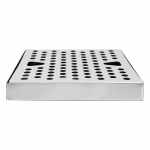Soil is an essential part of the ecosystem. It provides various products and services, including plants used for clothing, medicines, building materials and food. The minerals that make up soil particles produce makeup and dyes as well. – Soil Modification
Soil contains different characteristics naturally suitable for farming and construction. Environmental pollution greatly affects the quality of soil, making construction difficult. Trying to excavate the bad soil may be time-consuming and expensive.
Luckily modern techniques like soil modification can be used to improve the existing soil to your specifications. Modification strengthens the chemical and physical condition of the soil, improving its bearing capacity.
Since contaminated soil has a lot of challenges, this method is reliable in providing you with satisfying solutions. Check out some of the most rated soil modification techniques in construction.
- Mechanical technique
Mechanical solution is one of the most common techniques. This method helps in changing the physical property of soil. The operators use compaction and densification of soil through applying mechanical energy using rammers, vibration techniques, rollers or blasting and a change in gradation and solidity is achieved.
Carefully, compacting two or even more soils with different grading is key during the process. Materials such as silts and clay are added to enable the binding of non-cohesive soils, which greatly increases the strength of the final product.
The result is dense and well-graded soil. Clay has good binding properties and can stabilize sand and gravel particles that cause internal friction during the mixing of soils. It is advisable to factor in things like strength and concentration of the materials, the soil’s climatic and environmental condition, and the amount of soil binding taking place.
- Chemical technique
Chemical soil maintenance techniques involve the addition and mixing of similar chemical agents used to modify the soil. Chemical additives including cement, kiln dust, lime, and fly ash are added to soil to dry, improve workability, and stabilize soil properties.
Cement is the best reagent for low cohesion soils like clay that contain large granular particles. This reagent chemically hydrates when mixed with water and hardens rapidly. Depending on the nature and condition of the soil in a particular site, the reactions sought are either cementitious in nature or pozzolanic.
Lime on the other hand, contains oxides and hydroxides of magnesium and calcium, which helps stabilizes the effects of clay soils permanently. Lime reagents are naturally alkaline and raise the soil pH resulting in very resilient subgrades.
It is advisable to conduct proper laboratory testing, to determine the materials’ reactivity and dosage rates for proper modification. See this link to read more on how you can improve your soil for gardening https://www.thespruce.com/making-good-soil-out-of-bad-1402428.

- Compaction modification technique
In construction, the soil used is mainly compacted to serve various purposes such as constructing pavements for highways and airports, holding a water body or providing support to structures. This technique uses air voids expulsion in the soil, resulting in an end product that bears load without further compression.
Compaction improves the shear strength of soil and also reduces water absorption. Tamping rollers manually propelled vibrating plates, vibrating rollers, and tired pneumatic rollers are some of the various equipment used in attaining compaction.
In the dynamic procedure, a heavyweight is continuously dropped to pound deformities to achieve a uniform surface at regular intervals. The vibratory Vibro techniques is another method that uses vibrations to ensure compaction is attained.
The main goal of compaction modification technique is to achieve a moisture level to allow proper completion of compaction by drying the soil. For the best results ensure you are working with well-equipped and experienced operators.
- Polymer soil modification technique
Technology has opened up opportunities for new soil modification techniques in construction. The polymer technique involves the addition of polymers to improve and increase the strength of soil through their interaction with clayey.
Currently, polymers are used to increase the capability of the soil to retain water. Polycondensation polymers are easy to prepare, cost-effective and are also eco-friendly. They can be mixed with soil materials in liquid form to fill soil pores and harden soil structure.
In addition, they greatly reduce soil erosion without affecting the permeability of the soil. It is advisable to always consider professional advice before and during the process. Click here to read more.
Conclusion
The role of soil is fundamental when designing and constructing any structure. Soil simply acts as an effective medium for load transfer to the earth. Organizations in the construction industry have greatly benefited from the above-discussed techniques. Modification saves time and money and helps you achieve the desired specifications. Look for licensed engineers who have good experience and go through their reviews from other clients. You can choose one of the techniques discussed above depending on the soil’s environmental condition and composition for the best results. Lastly, ensure you carry out intensive laboratory tests on your soil to decide the best modification technique that will favor you.












